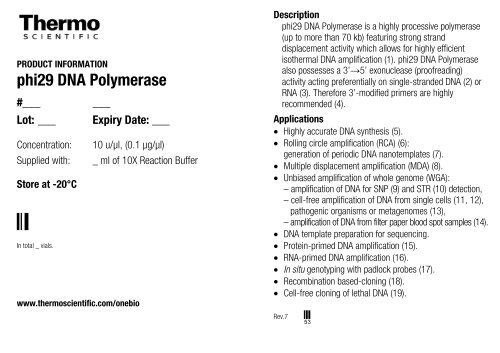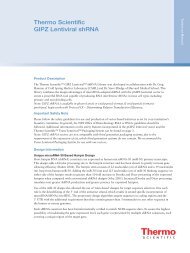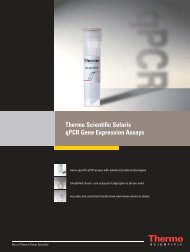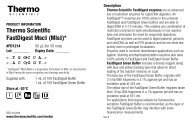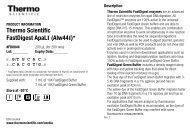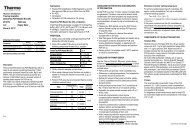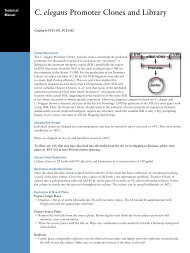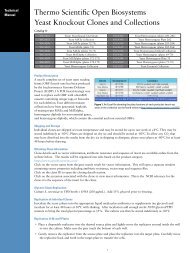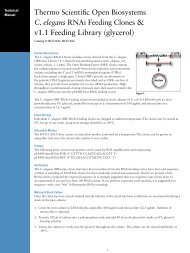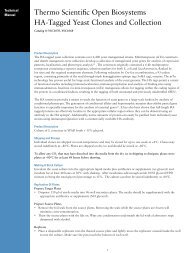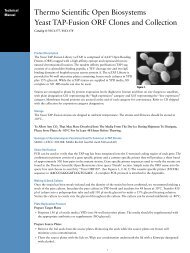phi29 DNA Polymerase - Product Information - Thermo Scientific
phi29 DNA Polymerase - Product Information - Thermo Scientific
phi29 DNA Polymerase - Product Information - Thermo Scientific
Create successful ePaper yourself
Turn your PDF publications into a flip-book with our unique Google optimized e-Paper software.
PRODUCT INFORMATION<strong>phi29</strong> <strong>DNA</strong> <strong>Polymerase</strong>#___Lot: ___Concentration:Supplied with:Store at -20°C}In total _ vials.___Expiry Date: ___10 u/µl, (0.1 µg/µl)www.thermoscientific.com/onebio_ ml of 10X Reaction BufferDescription<strong>phi29</strong> <strong>DNA</strong> <strong>Polymerase</strong> is a highly processive polymerase(up to more than 70 kb) featuring strong stranddisplacement activity which allows for highly efficientisothermal <strong>DNA</strong> amplification (1). <strong>phi29</strong> <strong>DNA</strong> <strong>Polymerase</strong>also possesses a 3’→5’ exonuclease (proofreading)activity acting preferentially on single-stranded <strong>DNA</strong> (2) orRNA (3). Therefore 3’-modified primers are highlyrecommended (4).Applications• Highly accurate <strong>DNA</strong> synthesis (5).• Rolling circle amplification (RCA) (6):generation of periodic <strong>DNA</strong> nanotemplates (7).• Multiple displacement amplification (MDA) (8).• Unbiased amplification of whole genome (WGA):– amplification of <strong>DNA</strong> for SNP (9) and STR (10) detection,– cell-free amplification of <strong>DNA</strong> from single cells (11, 12),pathogenic organisms or metagenomes (13),– amplification of <strong>DNA</strong> from filter paper blood spot samples (14).• <strong>DNA</strong> template preparation for sequencing.• Protein-primed <strong>DNA</strong> amplification (15).• RNA-primed <strong>DNA</strong> amplification (16).• In situ genotyping with padlock probes (17).• Recombination based-cloning (18).• Cell-free cloning of lethal <strong>DNA</strong> (19).Rev.7V
SourceE.coli cells with a cloned gene 2 of Bacillus subtilis phage<strong>phi29</strong>.Definition of Activity UnitOne unit of the enzyme catalyzes the incorporation of0.5 pmol of dCMP into a polynucleotide fraction(adsorbed on DE-81) in 10 min at 30°C.Enzyme activity is assayed in the following mixture:50 mM Tris-HCl (pH 7.5), 10 mM MgCl 2, 1 mM DTT,0.01 mg/ml lambda <strong>DNA</strong>/HindIII, 0.2 µM dCTP including[ 3 H]-dCTP, 0.2 mM dATP, 0.2 mM dGTP, 0.2 mM dTTP.Storage BufferThe enzyme is supplied in: 50 mM Tris-HCl (pH 7.5),0.1 mM EDTA, 1 mM DTT, 100 mM KCl,0.5% (v/v) Nonidet P40, 0.5% (v/v) Tween 20 and50% (v/v) glycerol.10X Reaction Buffer330 mM Tris-acetate (pH 7.9 at 37°C),100 mM Mg-acetate, 660 mM K-acetate,1% (v/v) Tween 20, 10 mM DTT.Inhibition and Inactivation• Inhibitors: aphidicolin, N 2 -(p-n-butylphenyl)-dGTP(BuPdGTP), 2-(p-n-butylanilino)-dATP (BuAdATP) (20).• Inactivated by heating at 65°C for 10 min.NoteAddition of Pyrophosphatase (#EF0221) to the <strong>phi29</strong>reaction mixture may enhance <strong>DNA</strong> synthesis (8).CERTIFICATE OF ANALYSISDouble-stranded Endodeoxyribonuclease AssayNo conversion of covalently closed circular <strong>DNA</strong> to nicked<strong>DNA</strong> was detected after incubation of 100 units of <strong>phi29</strong><strong>DNA</strong> <strong>Polymerase</strong> with 1 µg of ΦX174 RF1 <strong>DNA</strong>for 4 hours at 30°C.Single-stranded Endodeoxyribonuclease AssayNo degradation of closed circular <strong>DNA</strong> was detected afterincubation of 100 units of <strong>phi29</strong> <strong>DNA</strong> <strong>Polymerase</strong> with1 µg of single-stranded M13 mp19 <strong>DNA</strong> for 4 hoursat 30°C.Quality authorized by:Jurgita Zilinskiene(continued on back page)
References1. Blanco, L., et al., Highly Efficient <strong>DNA</strong> Synthesis by the phage <strong>phi29</strong><strong>DNA</strong> <strong>Polymerase</strong>. Symmetrical mode of <strong>DNA</strong> replication, J. Biol.Chem., 264, 8935-8940, 1989.2. Garmendia, C., et al., The bacteriophage <strong>phi29</strong> <strong>DNA</strong> polymerase, aproofreading enzyme, J. Biol.Chem., 267, 2594-2599, 1992.3. Lagunavicius, A., et al., Duality of polynucleotide substrates forPhi29 <strong>DNA</strong> polymerase: 3’→5’ RNase activity of the enzyme, RNA,14, 503-513, 2008.4. Skerra, A., Phosphorothioate primers improve the amplification of<strong>DNA</strong> sequences by <strong>DNA</strong> polymerases with proofreading activity,Nucleic Acids Res., 20, 3551-3554, 1992.5. Esteban, J.A., et al., Fidelity of <strong>phi29</strong> <strong>DNA</strong> polymerase, J. Biol.Chem., 268, 2719-2726, 1993.6. Lizardi, P. M., et al., Mutation detection and single-moleculecounting using isothermal rolling-circle amplification, Nat. Genet.,19, 225-232, 1998.7. Simmel, F.C., et al., Periodic <strong>DNA</strong> nanotemplates synthesized byrolling circle amplification, Nano Letters, 4, 719-722, 2005.8. Dean, F.B., et al., Comprehensive human genome amplificationusing multiple displacement amplification, Proc. Natl. Acad. Sci.USA, 99, 5261-5266, 2002.9. Wojnowski, L., et al., Genome-wide single-nucleotide polymorphismarrays demonstrate high fidelity of multiple displacement-basedwhole-genome amplification, Electrophoresis, 26, 710-715, 2005.10. James, M.R., et al., Evaluation of multiple displacement amplificationin a 5 cM STR genome-wide scan, Nucleic Acids Res., 13, e1191,2005.11. Gadkar V, Rillig MC., Suitability of genomic <strong>DNA</strong> synthesized bystrand displacement amplification (SDA) for AFLP analysis,genotyping single spores of arbuscular mycorrhizal (AM) fungi, J.Microbiol. Methods, 63, 157-164, 2005.12. Sgaramella, V., et al., Towards the analysis of the genomes ofsingle cells, Further characterisation of the multiple displacementamplification, Gene 372, 1-7, 2006.13. Matsunaga, T., et al., Whole-metagenome amplification of amicrobial community associated with scleractinian coral by multipledisplacement amplification using <strong>phi29</strong> polymerase, EnvironmentalMicrobiology, 8, 1155-1163, 2006.14. Andersen, P.S., et al., Whole genome amplification on <strong>DNA</strong> fromFilter paper blood spot samples, an evaluation of selected systems,Genetic Testing, 11, 200715. Blanco, L., et al., Terminal protein - primed <strong>DNA</strong> amplification, Proc.Natl. Acad. Sci. USA, 91, 12198-12202, 1994.16. Lagunavicius, A., et al., Novel application of <strong>phi29</strong> <strong>DNA</strong> polymerase:RNA detection and analysis in vitro and in situ by target RNA-primedRCA, RNA, 12, 765-771, 2009.17. Larsson, C., et al., In situ genotyping individual <strong>DNA</strong> molecules bytarget-primed rolling-circle amplification of padlock probes, Nat.Methods, 1, 227-232, 2004.18. M. B. Jakov and P. D. Kassner, Multiple displacement amplificationproducts are compatible with recombination-based cloning,BioTechniques, 42, 706-708, 2007.19. Hutchison CA et al., Cell-free cloning using <strong>phi29</strong> <strong>DNA</strong> polymerase,Proc. Natl. Acad. Sci. U S A 29,102, 17332-17336, 2005.20. Blanco, L., Salas, M., Effect of aphidicolin and nucleotide analogs ofon the phage <strong>phi29</strong> <strong>DNA</strong> polymerase, Virology, 153, 179-187,1986.
Use of this enzyme in certain applications may be covered by patents and mayrequire a license.PRODUCT USE LIMITATIONThis product is developed, designed and sold exclusively for research purposes andin vitro use only. The product was not tested for use in diagnostics or for drugdevelopment, nor is it suitable for administration to humans or animals.Please refer to www.thermoscientific.com/onebio for Material Safety Data Sheet ofthe product.© 2012 <strong>Thermo</strong> Fisher <strong>Scientific</strong> Inc. All rights reserved. All trademarks are theproperty of <strong>Thermo</strong> Fisher <strong>Scientific</strong> Inc. and its subsidiaries.


